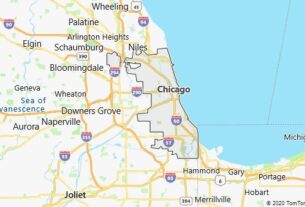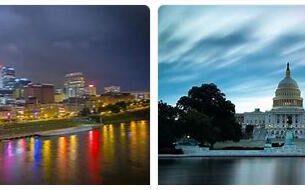Florida is a state in the southeastern United States of America. Due to its warm climate and location between the Gulf of Mexico, the Caribbean and the Atlantic Ocean, it is considered the Sunshine State. A particularly large number of vacationers come to Florida to enjoy the consistently warm climate and the long sandy beaches.
In 1845 Florida was incorporated as the 27th state of the USA. The state of Florida covers an area of 170,304 km², of which about 30,000 km² consists of water. The capital of Florida is Tallahassee and the emblematic animal of Florida is the Florida panther.
Because Florida is on a peninsula, few neighboring states, such as Georgia and Alabama, share its borders.
Florida climate
Florida is divided into two climate zones: the northwestern region is subtropical humid and the rest is tropical humid. Tropical storms often hit Florida from June to November. The winters are warm with temperatures around 25 °C. Snow is very rare in Florida.
Florida attractions
Famous sights in Florida are: Disney World, Miami Beach, Everglades National Park and the Florida Keys, which are connected by 42 bridges.
UNESCO World Heritage Sites
everglades
National Parks in Florida
Biscayne National Park
Dry-Tortugas National Park
Cities and interesting places in Florida
Tallahassee
Celebration
Fort Lauderdale
Jacksonville
Miami
Miami Beach
Orlando
Saint Petersburg
Tampa
Universities in Florida
Florida State University
University of South Florida
University of Florida
Florida International University
University of Central Florida
Florida Atlantic University
University of Miami
Airports in Florida
Fort Lauderdale-Hollywood International Airport / FLL
Jacksonville International Airport / JAX
Miami International Airport / MIA
Orlando International Airport / MCO
Southwest Florida International Airport (Fort Myers) / RSW
Tampa International Airport / TPA
Palm Beach International Airport / PBI
Rivers & Lakes in Florida
Lake Apopka
Lake Jackson
Lake Kissimmee
Lake Munson
Lake Okeechobee
Lake Seminole
Mountains & Hills in Florida
British Hill
Everglades Nationalpark in Florida – Everglades Park
Everglades National Park is located in southern Florida, United States.
The Everglades stretch from Lake Okeechobee in the north to the extreme southern tip of the Florida Peninsula. With an area of 6104 km², the national park extends into the Everglades. The national park was founded in 1947, it consists of a swampy landscape that is home to countless plant and animal species.
The Everglades have been a UNESCO World Heritage Site since 1979, but they are on the Red List of World Heritage in Danger. This is due to increasing pollution and the effects of Hurricane Andrew in 2005. Especially the area around the city of Flamingo.
The national park’s water is used to provide drinking water for Miami, putting the Everglades’ ecosystem at great risk.
The national park can be explored on developed paths. The Shark Valley on Highway 41 about 35 km south of Miami and the Anhinga Trail, 1 km to the left after the park entrance on State Road 9336, are popular for this.
The only wild flamingos in the United States live in Everglades National Park in Florida. It is also the only region on earth where both crocodiles and alligators live at the same time.
Other animals found in Everglades National Park include ibises, pelicans, cormorants, storks, raccoons, black bears, snakes, manatees, spider species and cougars.
The highest point in Everglades National Park is 8 feet above sea level. On average, the national park consists of a swamp landscape.
Half of the area of the Everglades in Florida is used for agriculture today, the other half belongs to the national park and the adjacent nature reserve.
Everglades National Park is accessible by car from Florida City near Homestead via State Road SR 9336 and approximately 40 miles southwest of the city of Flamingo. There is also a campground at Everglades City Flamingo.
Popular activities in the national park include hiking, canoeing, fishing and aiboat tours of the Everglades.
Airboat tours in the Everglades are offered from the town of Flamingo through the mangrove forests. You can ride it on the Wilderness Waterway from Flamingo to Everglades City. The drive then goes over 160 kilometers to Everglades City. You can find out more about it at the Everglades Visitor Center. In addition, films about the National Park Everglades are offered in the visitor centers. Visitor Centers are located in Royal Palm and Flamingo.
Guided hikes and tours of the Everglades are offered by park rangers during peak season (December through May).
Everglades National Park is open all year round. Accommodation such as motels are located in Falmingo.
The address of the Everglades National Park attraction in Florida
Everglades National Park
40001 State Road 9336
Homestead, Florida 33034-6733
USA
//www.nps.gov/ever/index.htm
Plantation
Population: 87,900 thousand people (2010)
Area: 56.8 sq. km
Founded: 1941
City status since: 1953
Time zone: UTC-5, summer UTC-4
Altitude: 2 m
Nearest airport: Fort Lauderdale
30 kilometers north of Miami, in Broward County, in the state of Florida, USA, the city of Plantation is located, surprising with the beauty of the trees growing there. The city is part of the Miami Capital Region. Plantation is surrounded by several cities: Sunrise, Lauderhill, Boulevard Gardens, Broadview Park, Weston. Plantation is a flat city. From its eastern border to the ocean, approximately 11 kilometers. The main sectors of the economy developed in the Plantation are education, healthcare, and social services. The Plantation has many beautiful parks, sports facilities, and camping sites.
The city of Plantation was founded in 1941, when Frederick Peters bought a plot of land on the site of the future city. Despite the fact that in 1947 the houses built were destroyed by floods and hurricanes, the following year 12 houses appeared here. In 1953, Plantation received city status. Already in 1957, the first plant began to operate, in 1959 the first school was opened. And in 1980, the City Historical Museum began to operate in the Plantation. In 2005, Hurricane Wilma caused significant damage to the Plantation.



